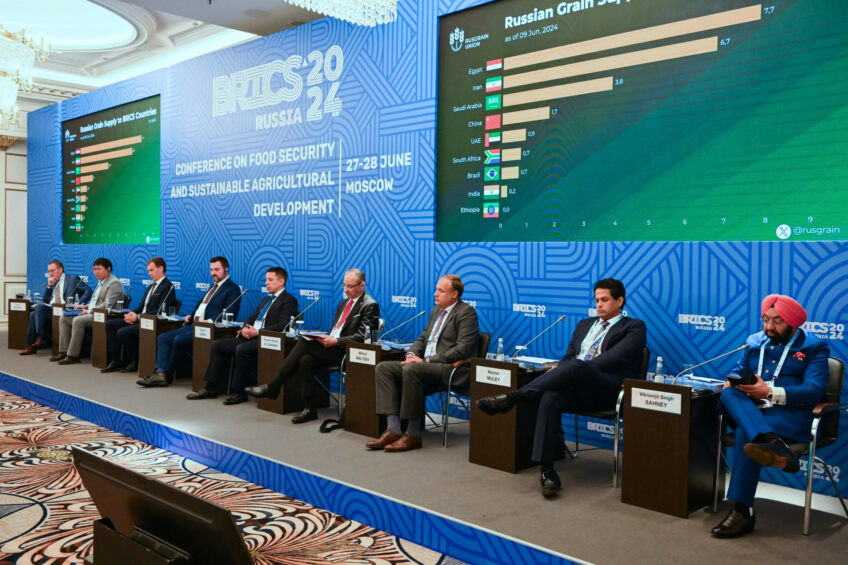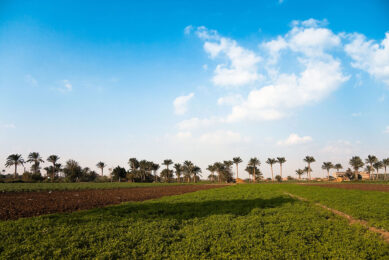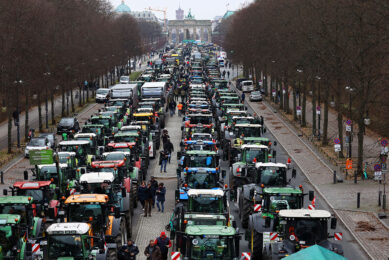BRICS countries are unlikely to disrupt the global feed industry

Trade rapprochement within the BRICS bloc of emerging countries may seem to promise tectonic shifts to the global feed industry, but as practice shows, promises are not always fulfilled.
BRICS countries have enormous potential to expand agricultural trade among their members, as several officials and business representatives outlined during the BRICS 2024 conference on food security and sustainable agricultural development held in Moscow on June 28, 2024.
“Mutual trade between the BRICS countries is developing successfully and rapidly. Between 2018 and 2022, BRICS members ramped up agricultural exports by 43%,” Dmitry Krasnov, head of Agroexport, a Russian government agency facilitating food exports, claimed during the event. BRICS countries account for over 30% of global agricultural land, 40% of dairy products and over 50% of fish and seafood production, Krasnov calculated.
Superpower in global agri-market
BRICS is a superpower of the global agricultural market, Eduard Zernin, chairman of the Russian Union of Grain Exporters, stated. In the 2023/24 season, members of the trade bloc accounted for 36% of rice, 30% of corn, and 28% of wheat exports. Zernin also called for better synergy between the BRICS food industries, reminding that the bloc includes not only the world’s largest exporters but also the biggest importers of agricultural products.
Calls for harmony within the trade bloc
Not only Russian officials call for trade rapprochement within the bloc. Dr Vikramjit Singh Sahni, Chairman of the BRICS Business Council on Agriculture from India, also said that the member states must take steps to facilitate trade, including unifying production standards and establishing a BRICS information portal for data exchange.
Hong Wei, head of the foreign department of the Chinese Jiangsu Provincial Foreign Trade Corporation, in turn, claimed that China is experiencing a major shift in consumer preferences. Residents are striving to have healthier food on their tables, and BRICS can certainly help. For example, he said, Russian food can help China meet growing demand, including in the GMO-free agricultural products segment.
A market cartel
Among other things, BRICS members also mull establishing an inter-organisation grain exchange, targeting to form an analogue of the OPEC+ cartel for the key agricultural commodities. The strategy looks potentially detrimental to the global feed industry, as its ultimate goal is to put an end to free pricing on the key feed crops. The first official steps towards establishing inter-BRICS grain exchange are due to be made during the trade bloc’s political leaders meeting in October 2024, Eduard Zernin, chairman of the Russian Union of Grain Exporters, has recently unveiled, saying nothing about what steps are planned. Under the commodity exchange project, members of the organisation will provide different commodities, Zernin said. For example, Russia will focus on wheat and other grain crops, Brazil on corn and soybeans and India on rice.
Russia pushes for grain exchange
Russia has been pushing other BRICS members hard to establish inter-BRICS grain exchange since the idea initially popped up in December 2023. “A BRICS grain exchange could bolster Moscow’s geo-economic influence over the participating nations. It would reinforce Russia’s role as a vital supplier of grain and fertiliser to these countries, enhancing their economic reliance and maintaining the government’s considerable economic and diplomatic leverage,” Genevieve Donnellon-May, Asia Society Policy Institute Research Associate.
The idea of such an exchange, to put it simply, is to create a cartel.

Price regulation
The project’s endgame is to revise the existing pricing system on the global market, Russian officials indicated. The BRICS grain exchange will facilitate the establishment of “fair prices” on the global markets, independent from existing exchanges and benchmarks, Zernin told a local news outlet Pole. Regulating prices for the key agricultural commodities is the key rationale behind establishing the new grain exchange, Alexander Dynkin, president of the Moscow-based IMEMO institute under the Russian Academy of Science, claimed. “The idea of such an exchange, to put it simply, is to create a cartel. In general, it will resemble OPEC, thanks to which oil prices remain higher than they could be without coordination between exporting countries,” Dynkin was quoted as saying by the Russian government’s publication Russian Gazette.]
“Most benchmarks are set either in the US or in Europe. Moreover, they [Western players] can regulate them not in Russia’s favour. Ultimately, this affects pricing. Own price regulation tools within BRICS will strengthen the cohesion of the association and will allow attracting new participants,” said Konstantin Lebedev, professor at the Department of International Business at the Financial University under the Russian government.
The launch of the BRICS agricultural exchange will give Russia strategic advantages in the global food market, the publication asserted.
A cross-cutting theme
The discussed trade rapprochement has other dimensions. Several countries in the region see this as a chance to replace the products of non-BRICS countries in the markets of other BRICS member states. This is, in the first place, true for China and Russia, both of which are locked in a tussle with Western countries.
When trade ties become stronger between a potential supplying third country and another third country that is a traditional destination of EU products, they can indeed impact the EU’s situation on that third country market.
Impact on European pig sector
China’s potential imposition of anti-dumping measures on European Union pork imports, discussed as a retaliatory measure to the EU EV tariffs, undoubtedly will be a disastrous scenario for the European pig industry. However, it will also be open a huge window of opportunities for the Russian pig industry, which is striving to ramp up exports to China after the country withdrew a 15-year ban on the Russian pork in 2023.
European dairy sector – could loss competitive edge
Russian dairy union Soyuzmoloko also rolled out plans to boost exports to China, taking advantage of a generous 100% logistics subsidy offered by the Russian authorities. Artem Belov, chairman of the organisation, openly said that Russian dairy firms could grab the share of European companies, who partly lose their competitive edge on the global market, owing to the green transition.
Impact on EU’s situation on third country market
The BRICS trade rapprochement has somewhat bothered the European agricultural sector, as indicated by officials. “When trade ties become stronger between a potential supplying third country and another third country that is a traditional destination of EU products, they can indeed impact the EU’s situation on that third country market,” Olof Gill, European Commission’s Spokesperson for Trade and Agriculture, told All About Feed. However, Gill indicates that the EU is a traditional supplier of pork to China, and the main factor that has so far influenced its position in the Chinese pork market has been China’s own capacity to supply its population with domestic pigs. This capacity can at times be strongly affected by the spread of African Swine Fever decimating pig populations in China, Gill indicated. He also assumed that it is likely to continue having a stronger impact than the potential pork supply from Russia for the time being.
Not an imminent threat
Still, the real trade rapprochement sought by some members is likely a matter of a distant future. It may take a few years to make the inter-BRICS grain exchange project real, Zernin admitted.
There are still numerous questions yet to be answered about the project. Alexander Korbut, former deputy head of the Russian Grain Union, for example, pointed out that BRICS includes both food exporters and importers, unlikely OPEC, which primarily comprises crude oil exporters. This means that the idea of artificially regulating prices will undoubtedly face a resistance from key importers, Korbut said. “Buying food at inflated prices is contrary to the interests of importers, but exporters will not agree to make big discounts either. I believe that prices on the BRICS exchange will not differ much from prices on other exchanges,” Korbut assumed.
The European Commission has declined to say whether European officials fear that the BRICS grain exchange can impact the European grain and feed markets. All parties in BRICS have a common request to reduce costs in settlements, Korbut noted. “This is the task that the new exchange is capable of solving. This will become possible thanks to new digital settlement systems that are already being developed. The US will not be able to control them and dictate their terms,” the expert said.
BRICS lacks structure
Still, as BRICS has no intergovernmental institutions or organisational structure, the prospects of mechanisms facilitating trade between its members remain vague, especially since most bloc members are eager to protect domestic markets. “The BRICS grain market is uneven. For example, China cannot always buy Russian grain due to the lack of special certificates. And not all types of Russian grain have this certification,” Yulia Khandoshko, CEO of the European broker Mind Money, said. “Everything is complicated by the fact that Russia often changes the duties on grain exports since this is a strategically important commodity. Imagine if a certain type of grain is put on the exchange, but it does not have a Chinese certificate. And while the grain was receiving this certificate, a new export duty appeared,” Khandoshko said.
All in all, it looks like the BRICS projects like grain exchange, even if established, will not bring about new challenges for the global feed industry in the foreseeable future.











